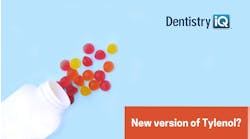By Linda Douglas, RDH
Although our dental education includes the essentials of salivary gland anatomy and physiology, few of us were enthralled at the time. In recent years that has changed for me; my desire to improve support for patients with salivary gland hypofunction has instigated a more in-depth study of saliva. This has made me aware that there is so much more to this topic than I first thought. It actually turns out to be vastly compelling after all, and well worth sharing with my colleagues. To this end, I have compiled some fascinating facts about saliva.
The other salivary glands
In addition to the major salivary glands, and accessory glands situated throughout the oral mucosa, there are other specialized sources of saliva secretion:
The uvula1 — Most of the soft palate has glands that produce mucinous saliva; however, the uvula secretes thin saliva, which is released by muscle contraction.2 The uvula is composed of connective tissue, glandular tissue, and diffused, interdigitated muscle fibers. It moves back and forth, releasing fluid when needed to lubricate the postpharyngeal areas, facilitating speech.3 Individuals who have had uvulectomy (usually for snoring and sleep apnea) may report complaints of dryness in the throat area.
Von Ebner’s glands — Taste cells in the circumvallate papillae are bathed by serous secretions from Von Ebner’s glands, which contain gustin, zinc, and lipase.
Innervation
The salivary glands are regulated by the autonomic central nervous system. The sympathetic response produces viscous saliva that is low in volume and high in protein. The sympathetic nervous system also affects salivary gland secretions by innervating the blood vessels that supply the glands. Parasympathetic stimulation produces watery saliva that is high in volume and ions, but low in protein.
Functions and properties of saliva
Saliva is essential for maintenance of the integrity of enamel:
- By modulating demineralization, and remineralization.
- Glycoproteins in the pellicle inhibit bacterial adhesion to the tooth surface, and reduce the erosive potential of cola drinks by up to 50%.4
- Saliva buffers acids by virtue of calcium, phosphate, bicarbonate, and urea to maintain the oral pH at 7.0 to 7.5.
Saliva contains epidermal, fibroblast and nerve growth factors for tissue repair. Gustin is necessary for growth and maturation of the taste buds.
Saliva is crucial for oral clearance: this can vary from 30 seconds in the mandibular anterior area, to 20 minutes around the maxillary anterior area. Certain drugs are excreted in the saliva.
Salivary amylase and lipase initiate digestion and mucin forms the food bolus for deglutition. Saliva is hypotonic to plasma in order to dilute food to the osmolality of plasma.
Swallowing saliva stimulates gastric secretions: recent studies by UK colorectal surgeon Alastair Windsor have found that patients recovered from bowel surgery sooner if they chewed gum.
Salivary peptides are antimicrobial, and secretory immunoglobulin ‘A’ neutralizes viruses and bacterial toxins.
Glycoproteins in mucinous saliva coat the oral surfaces to protect, lubricate, and facilitate speech, mastication, and swallowing. This also prevents esophageal damage.
Factors that influence salivary output:
- Salivary production is linked to overall body fluid balance and blood flow through salivary gland tissues.
- Antidiuretic hormone decreases salivary output.
- Circadian cycles influence salivation: salivary flow peaks in the late afternoon, and diminishes to almost zero during sleep.
- Olfactory stimulation temporarily increases salivary output.
- Anxiety and depression decrease salivary flow.
- Chewing gum increases resting and stimulated salivary flow.
Lesser-known factors affecting salivary flow:
- Salivary flow is lower when we are sitting than when standing, and is lower still when lying down.
- Salivary output is reduced by 3% to 40% if an individual is blindfolded or in the dark.
- Physical exercise produces sympathetic stimulation, which can diminish salivation.
- Estrogen and testosterone increase resting salivary flow.
- Mania increases salivation.5
Factors affecting salivary pH and buffering capacity:
- Diet.
- Salivary flow.
- Bacterial load.
- Gastric reflux.
A low salivary flow rate increases acidity by impairing saliva’s buffering capacity, and increasing numbers of acidogenic bacteria, which are also aciduric — thriving in an acidic environment. If low salivary pH occurs despite a normal salivary flow rate and buffering, the possibility of GERD should be considered.
The parotid gland’s unique anatomy
The parotid gland is the only salivary gland with intraparenchymal lymph nodes. This might play a role in the development of Warthin’s tumors and lymphoepithelial cysts within the parotid gland.
The future: saliva-based diagnostics for systemic diseases — a promising option
We currently assess salivary flow rate, pH, buffering capacity, cariogenic bacteria, and periodontal pathogens. However, almost anything that can be measured in blood can be measured in saliva,6 as systemic disease markers pass from the blood into saliva. Saliva tests are being developed to assess risk for ovarian, endometrial, cervical, and head and neck cancers.
The NIDCR Human Salivary Proteome research project is determining the total protein profile of saliva.7 For example: they have identified 49 proteins in saliva that distinguish healthy women from those at risk for breast cancer.
UCLA has developed the Oral Fluidic Nanosensor test (OFNASET). Saliva from individuals with head and neck cancer was profiled and analyzed: salivary mRNA and proteomic biomarkers were able to predict if a sample was from someone with oral cancer or from a healthy subject, with 82% accuracy.8 In a large Baltimore, Md., population-based study, elevated salivary cortisol was associated with poorer cognitive function.9
Saliva is often called the "body’s mirror";10 there is great potential for salivary diagnostics for systemic and oral diseases. It is noninvasive, cost-effective, and painless for the patient. Could this be what our future holds?
Click here to read a series of articles the author wrote on saliva for Dentinal Tubules, a UK website.
Author bio
Linda Douglas graduated in 1982, from the Royal Dental Hospital School of Dental Hygiene, in London, England, and studied dental assisting at the Eastman Dental Institute. After working in periodontology at The Royal Dental Hospital, and University College Hospital in London, she moved to Toronto, Canada, where she has worked in general and periodontal private practice since 1990.
References
1. Nancy Burkhart, RDH EdD. The Uvula. RDH magazine. Vol 28 Issue 9.
2. Finkelstein Y, Meshorer A, Talmi Y, Zohar Y, Brenner J, Gal R. The riddle of the uvula. Otolaryngol Head Neck Surg 1992; 107:444-450.
3. Back GW, Nadig S, Uppal S, Coatesworth AP. Why do we have a uvula? Literature review and a new theory. Clin Orolaryngol. 2004; 29:689-693.
4. Jensdottir et al, J Dent Res 2006; 85(3): 226-230.
5. Anne Marie Lynge Pedersen, Associate Professor, Ph.D. Institute of Odontology, University of Copenhagen, 2007.
6. Clinical Aspects of salivary biology for the dental clinician: Laurence J. Walsh Minim Interv Dent 2008; 1:7-24.
7. J. Max Goodson, DDS, PhD. Dimensions of dental hygiene. April 2009; 7(4):16-18.
8. Amy Neives RDH, Wendy Fitzgerel-Blue, RDH, BSDH. RDH magazine, Vol 28 Issue 5.
9. Lee BK, Glass TA, McAtee MJ, Wand GS, Bandeen-Roche K, Bolla, KI Schwartz BS. Associations of salivary cortisol with cognitive function in the Baltimore memory study. Arch Gen Psychiatry. Jul 2007; 64(7):810-8.
10. David T. Wong, DMD, DMSc. Dimensions of dental hygiene July 2006; 4(7):14-17.





